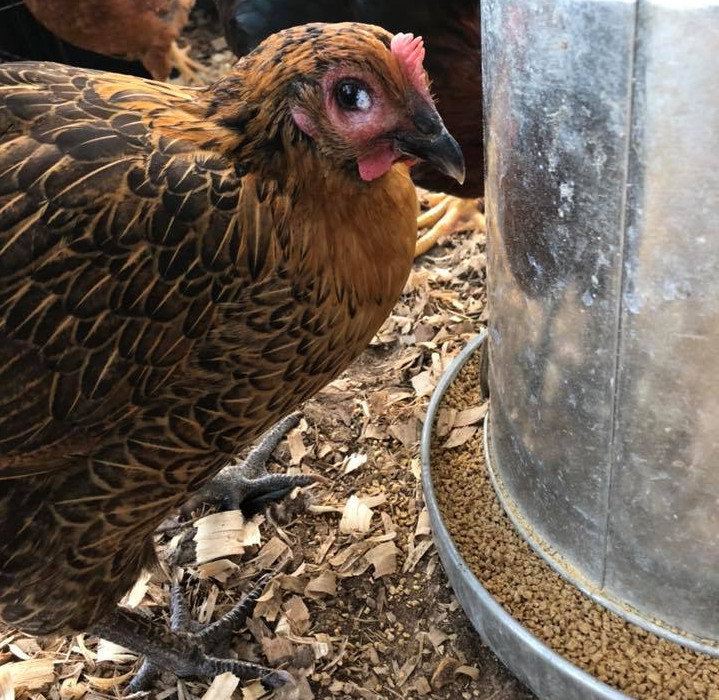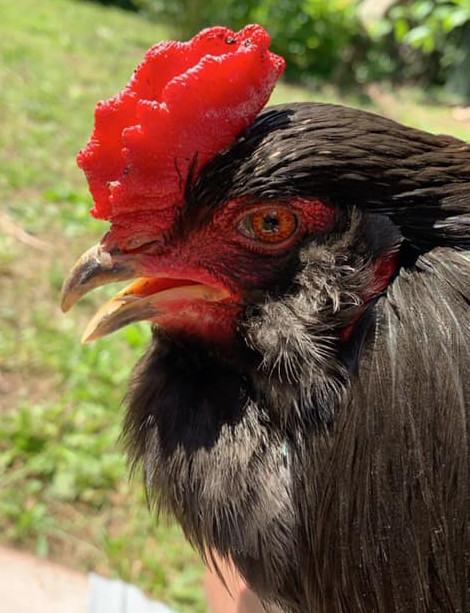Mycoplasma gallisepticum - MG - in chickens and how to deal with it

Mycoplasma infections are painful and distressing for chickens as they may end up gasping for breath and suffocating as well as having swollen heads.
Table of Contents
Mycoplasma gallisepticum (MG) and Mycoplasma synoviae (MS) infections are normally known as chronic respiratory disease (CRD) of chickens and it is characterised by bubbly or foamy eyes, sneezing, respiratory rales, nasal release, coughing, and conjunctivitis.
It is a long known poultry disease and in my grandfathers day it was called "Roup" and the common treatment back then was culling as he knew a bird that had the disease would pass it on and become unthrifty. It is often noticed around the fall as birds moult and are under stress.
Clinical appearances are generally slow to develop and the infection or disease may have a long course. The air sac malady describes a severe airsacculitis that is the after effect of MG or Mycoplasma synoviae (MS) infection complicated by a respiratory infection disease.
Below: A chicken with the classic eye and gaping beak symptoms.

The route of infection is via the conjunctiva or upper respiratory tract and the incubation period is 6-10 days. Transmission can be through the egg from the breeder birds or directly bird to bird through dust, feathers, aerosols, faeces and vectors such as people and equipment.
Birds can recover from Mycoplasma but will remain infected for life and subsequent stress may cause recurrence of disease.
Mycoplasma is a very small, slow-growing bacteria-like avian pathogen. It is not a virus but an " atypical bacteria" that lacks a cell membrane.
This is the most common respiratory disease, it is very infectious and is carried on the clothes and hands of people tending the birds, plus equipment.
It is found on all continents around the world and the organism is a sturdy one that can survive:
- Dessication or drying out.
- For 2-4 years at -30 C,
- In faecal dropping for 1-3 days at 20 C,
- Muslin cloth for 3 days at 20 C,
- Egg yolk for 18 weeks at 37 C and 6 weeks at 20 C,
- Human nasal passage for 24 hours,
- Cotton, rubber for 2 days,
- Human hair for 3 days,
- Feathers for 2-4 days,
- Paper for 7 days at 30 C
Mycoplasma gallisepticum: symptoms can include foamy eyes, sneezing, nasal discharge, swollen eyelids and sinuses, reduced egg production or reduced weight gain and gasping: This one is the main culprit in backyard flocks.
Mycoplasma synoviae: signs include swollen and hot joints and/or respiratory signs as above, and/or the broad end of eggs form weakened/discoloured shells.
Only the MG and MS infect chickens and both are very infectious and thrive in the bird when other pathogens are present, such as E. coli or infectious bronchitis. It is more common in free-range flocks.
You can eat the eggs and the meat of chickens infected with mycoplasma provided they are not currently being treated with an antibiotic or medicine that has an egg or meat withdrawal period.
The signs and symptoms of Mycoplasma infection:
One of the big problems with a mycoplasma infection is that it may take up to 3 weeks for you to notice your chickens are ill.
The first sign of a problem is a wet sounding sneeze and a discharge from the eyes and nostrils. There is a particular sweet smell associated with this discharge which to the sensitive nose is immediately apparent when entering a hen house.
The infectious agent survives only a few days, but has been shown to live longer on the feathers. MG can be transmitted by humans on hair and in the nostrils. Predisposing factors for clinical disease are the presence of respiratory viruses, other disease and challenging environmental conditions.
Mycoplasma needs to be confirmed by taking blood samples of a flock to check if the birds are positive. Subsequent blood samples may be necessary. Post mortem examination alone is not sufficient to diagnose this disease, although there are PCR test available to diagnose the presence of the genetic material in infected organs.
Clinical signs:
- Morbidity and mortality are variable highest in cold weather and young flock.
- Slow growth/stunting and leg problems.
- In the adult flock, the most naturally occurring signs are tracheal rales, nasal discharge and coughing.
- Inappetance, decreased feed intake, low weight gain and malaise.
- In layers a decrease in egg production and poor productivity and feed efficiency in broilers.
- Coughing, sneezing, swelling of one, or both infra-orbital sinuses.
- Conjunctivitis and kerato-conjunctivitis.
- Congestion of conjunctival vessels with nasal and ocular discharge.
- Facial swelling, eyelid and increase lacrimation.
- Sometime ataxia, lameness, swelling of the hock, and enlargement of the eyeball.
- It may be complicated with IB, NDV or E.coli known as CRD (Chronic respiratory disease)
- Clinical symptoms are generally more severe in male than female.
- Occasional encephalopathy and abnormal feathers.
- Reduced hatchability and chick viability.
How is Mycoplasma gallisepticum treated?
Treatment in chickens is generally with antibiotic agents that decrease clinical signs and vertical transmission however do not dispense with disease but will reduce the incidence to a tolerably low level.
The Mycoplasma gallisepticum incubation period fluctuates from 6–21 days and is similar for Mycoplasma synoviae. Mycoplasma will make some birds sicker than others.
This disease needs treatment as it will not get better if left alone and may go on to instigate other conditions in the flock.
Recovered birds have some degree of immunity but chickens carry the organism for the rest of their lives.
Most strains of Mycoplasma are susceptible to various broad-spectrum antibiotics agents, including tylan. Tylan or antibiotic medications have been regularly used to decrease egg transmission or as prophylactic treatment to forestall respiratory complications in chickens and turkeys.
Below: A Silkie with a mycoplasma infection.

There are no truly effective home or herbal remedies for MG in chickens. Colloidal silver is often touted as a remedy but it isn't considered safe or effective for any of the health claims. Silver has no known purpose in the body and not an essential mineral.
All home and herbal remedies can and should be given for palliative reasons to make the birds feel better and they may help with the chickens overall health but they won't cure the disease or speed recovery.
There is a mycoplasma vaccine but it is not recommended for use in laying and breeding chickens and it only appears effective for six months.
Once a bird is infected it is a carrier for life and may spread the disease and develop it again in the future.
Humans can not get mycoplasma from chickens. You can however carry the disease and spread it around so bio-security is a necessary precaution.
Mycoplasma gallisepticum and Mycoplasma synoviae are avian specific organisms with no zoonotic importance. A human can not get mycoplasma from chickens.
There are mycoplasma species that infect humans but these two only infect a narrow range of avian species and there is no public health significance.
Disinfectant are used to kill bacteria, ethanol and alkaline detergent formulations were particularly efficient against mycoplasma.
Follow the manufacturers instructions and use appropriate PPE. Not all products are available everywhere and some may not be certified for use in your location.
Be sure to clean out and replace the foot baths often they will not work if they sit out too long or fill up with dirt. If using bleach, replace daily and keep foot bath covered when not in use.
How is MG transmitted or spread?
Mycoplasma infections are transmitted vertically within some eggs (trans-ovarian) from infected breeders to their offspring via the eggs, and horizontally via infectious aerosols and through contamination of feed, water, and the environment, and by human activity (shoes, equipment).
Infection may be latent in some birds for days to months, but when birds are stressed horizontal transmission may occur rapidly via aerosols and the respiratory route, after which infection and clinical disease spread through the flock.
Horizontal transmission occurs promptly by direct and indirect contact of susceptible chickens with infected birds.
The upper respiratory tract and conjunctiva are portal of entry for the Mycoplasma gallisepticum organism in droplets and aerosol.
Vertical transmission of MG is known to happen in eggs laid by naturally infected chickens and has been prompted following experimental contamination of susceptible leghorn chickens. The highest rate of transmission was found during the acute period of the disease when MG levels in the respiratory tract are peaked.
Prevention of mycoplasma in chickens:
Mycoplasma is found everywhere in the world that there are chickens and turkeys.
In the US, the rate of MG in business poultry diminished impressively during the previous 50 years as the consequence of extensive control programs under the National Poultry Improvement Plan (NPIP).
Bio-security and good management practices are essential. Reduction of multiple age groups, low stocking densities, alongside implementing a vaccination programme, operating a closed flock where possible, antimicrobial treatments and reducing exposure to wild birds.
Other helpful methods to control the disease are:
- Strict bio-security.
- Prevention depends to a great extent on acquiring chicks or poults from a flock without M. gallisepticum.
- Destruction of infected birds.
- All in and all out systems.
- Inactivated vaccine available: limited value.
- Eye-drop, intranasal, and coarse spray, at 8-14 weeks or 2 weeks of age .
Disinfectant are used to kill bacteria, ethanol and alkaline detergent formulations were particularly efficient against mycoplasma.
Follow the manufacturers instructions and use appropriate PPE. Not all products are availible evrywhere and some may not be certified for use in your location.
Be sure to clean out and replace the footbaths often they will not work if they sit out too long or fill up with dirt. If using bleach, replace daily and keep footbath covered when not in use.
